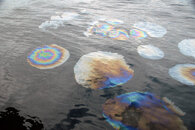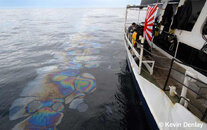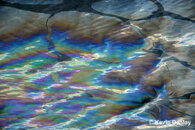While oil
spills are no laughing matter, one could at least be forgiven a smirk at the doom and gloom predictions (in the article) of the disasters awaiting in all the WWII wrecks worldwide. After all, I don’t recall one single report of a large oil slick, let alone it washing up on beaches / polluting shorelines from
any of the dozens and dozens and dozens of WWII wrecks completely, and I mean
completely, broken up and salvaged in the Java Sea, South China Sea or the Malacca Strait, starting about ten years so ago. Now of course there may have been some, but seemingly not enough to gain any / much attention. Or did I miss (or more likely forget

) something?
Below pics are of an oil ‘slick’ as seen in 2010 coming up and dispersing from the IJN heavy cruiser
Haguro (in the Malacca Strait
, but no need to worry about her disgorging her oil content anymore, she’s
gone!). These and all the other ‘slicks’ I have seen from wrecks I have dived worldwide all start out as a droplet of oil (have photos somewhere of them passing me by on deco) that ‘explode’ out into coloured circles on the surface and then spread out and drift away / disperse. Many of these releases are not regular daily events either, but are often current direction (or sometimes diver) related / dependent. That is, over say a week or more whilst on the one wreck these 'slicks' may be seen on only one or two days, sometimes not at all, or maybe every day at certain times if the current is ‘ripping’, or if divers are swimming through certain spaces in a wreck.

So although a catastrophic break up of a wreck (from an earthquake, time u/w decay, etc) could be a concern in some close to shore locations, the evidence, or actually the lack thereof, from the illegal wreck salvage that entailed breaking up of
complete vessels throughout south east Asia doesn't point to that being the case. Besides, how much oil is left on many of the wrecks that are left is, overall, a matter of speculation.
The below photos show, from left, the start of the ‘slick’ from
Haguro where the oil droplets reach the surface, the next where it can be seen floating away with the current, and the third how beautiful something so dirty can look.




 ) something?
) something?


